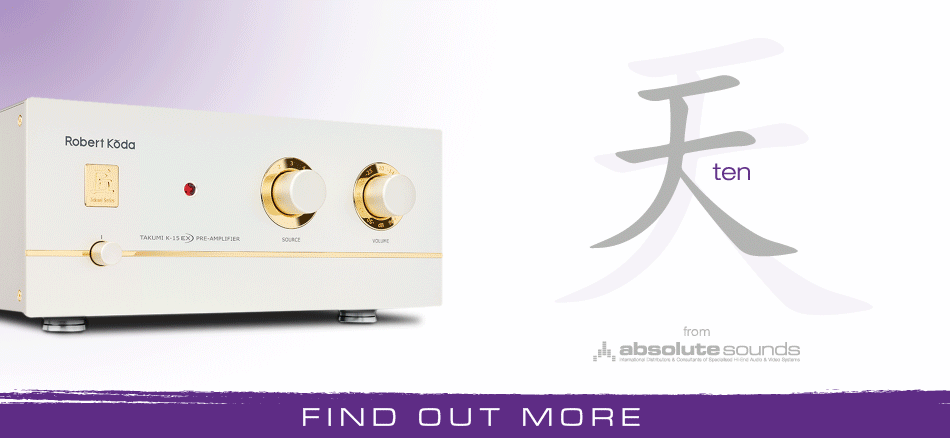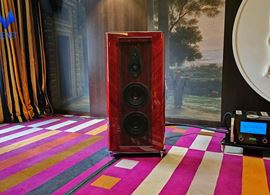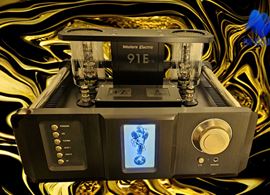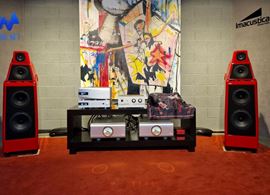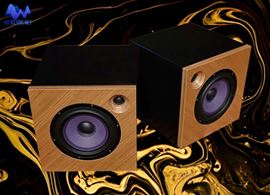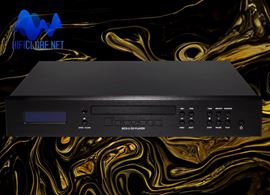 I’ve just experienced something wonderful: a two hour audition of The Sonus Faber at Imacústica's new premises, in Lisbon, driven by Krell Evolution One/Two and a Metronome Kalista Ultimate Limited Edition plus DAC as a digital source. This is something I strongly recommend if you are into music not just sound. Go to Imacústica and listen to what might very well be the best loudspeaker money can buy.
I’ve just experienced something wonderful: a two hour audition of The Sonus Faber at Imacústica's new premises, in Lisbon, driven by Krell Evolution One/Two and a Metronome Kalista Ultimate Limited Edition plus DAC as a digital source. This is something I strongly recommend if you are into music not just sound. Go to Imacústica and listen to what might very well be the best loudspeaker money can buy.
Acabei de ter uma experiência maravilhosa: uma audição de duas horas das colunas The Sonus Faber, nas novas instalações da Imacústica, em Lisboa, alimentadas por Krell Evolution One/Two e com um Metronome Kalista Ultimate Limited Edition+DAC, como fonte digital. Isto é algo que eu recomendo fortemente, se gosta de música, e não apenas de som, vá à Imacústica ouvir o que podem muito bem ser as melhores colunas de som que o dinheiro pode comprar.
Note: sound in this HDVideo was overdubbed (neste video o som foi sobreposto) I did just that last Saturday. Luís Campos, a CD master magician, was my kind host and that meant as always a guided tour across the green pastures of great classical music. Memorabilia like Fritz Reiner conducting the Chicago Symphony Orchestra performing Rachmaninoff piano concert nr 2. Or Gershwin’s I’ve got rhythm variations by Grofé, with Lincoln Mayorga and the Harmonie Ensemble of New York. Foi o que eu fiz, no Sábado passado. Luís Campos, o mágico do CD, foi o meu simpático anfitrião-demonstrador, o que significa sempre uma viagem guiada pelas verdes pastagens da grande música clássica. Tesouros como Fritz Reiner, dirigindo a Orquestra Sinfónica de Chicago, em obras de Rachmaninoff. Ou as variações de Grofé sobre I've got rhythm, de Gershwin, com Lincoln Mayorga e o Harmonie Ensemble de Nova Iorque.
We even listened to a cocktail of Portuguese fado (typical song) by Katia Guerreiro and Brazilian bossa nova by João Gilberto/Stan Getz, with the inevitable incursion in Ney Matogrosso’s secret discography (Luís is a long time fan of this extraordinary Brazilian singer).
Até ouvimos um cocktail de fado bem português, por Katia Guerreiro, e bossa nova, pela dupla João Gilberto/Stan Getz, com a inevitável incursão na discografia secreta de Ney Matogrosso (o Luís é uma fã de longa data deste extraordinário cantor brasileiro).
It was only here that I detected what was just a hint of imperfection in the otherwise perfect audition. I dare say, I heard a slight unwelcome midbass emphasis, a touch of chestiness in Katia’s voice, which I atributed to a sound engineer’s trick, no doubt to give it more body, and an artificial “caveau club” ambience around Ney’s contralto tone (Estava Escrito) that 'THE' immediatly denounced. Foi apenas aqui que detectei uma mera sugestão de imperfeição, numa longa audição, de outro modo perfeita. Ouso dizer que ouvi uma ligeira, e nada bem vinda, ênfase nos registos médio graves: um toque de 'peito', na voz de Katia, que atribuí a um truque do engenheiro de som para lhe conferir mais corpo; e uma ambiência de 'clube caveau' que envolvia o tom de contralto de Ney (Estava Escrito), que 'THE' denunciou imediatamente.
Mind you, having an amiable character in the upper registers (massed strings sound organic and true), The Sonus Faber does not forgive sound engineering 'punches' below the belt. Now you are warned. Be honest and frank with her and she will deliver more than you ever imagined possible.
Atenção, embora de carácter amigável nos registos altos (os violinos em uníssono soam orgânicos e verdadeiros), as colunas The Sonus Faber não perdoam 'socos' dos engenheiros de som abaixo do cinto. Sejam honestos com elas, e elas retribuirão de uma forma que nunca imaginou possível.
An engineering masterpiece in itself, “THE” is the least “mechanical” loudspeaker system I have ever heard. A memorable audition of the huge Soundlab electrostatics at the Venetian, in Vegas, came immediatly to mind.
Sendo uma obra prima da engenharia, 'THE' é a coluna menos 'mecânica' que já ouvi. Uma audição memorável das enormes Soundlab, no Venetian, em Las Vegas, ocorreu-me de imediato.
In the absence of vibrations or resonances, silence below is so deep that low level resolution is uncanny in its emotional content. The often rough and winding road from micro to macro dynamics, that music so often has to tread with lesser loudspeaker systems, is here so smoothly paved with uncompressed tiles of crystalline, yet powerful, transients that the ebb and flood of natural sound becomes a fulfilling, invigorating, exhilarating experience.
Na ausência de vibrações ou ressonâncias, o patamar do silêncio é tão profundo que a resolução de baixo nível é quase sobrenatural, assim como o seu conteúdo emocional. O difícil e ondulante caminho, que vai da micro à macro dinâmica, e que a música tem tantas vezes de percorrer, com colunas de menor qualidade, está aqui pavimentado com suaves e cristalinos mosaicos de transitórios sem compressão, e tão poderosos, que a fluidez do som natural se torna uma experiência plenamente satisfatória, revigorante e até estimulante.
Renata Tebaldi singing Si,mi chiamano Mimi/La Bohème left me with goose bumps from head to toe. And Lord knows that once you turn 60 you don’t have that many chances to feel this most peculiar and enjoyable of involuntary reflex actions. At least I hadn’t since my last live opera concert sitting four rows from the soprano.
Renata Tebaldi, cantando Si,mi chiamano Mimi/La Bohème, deixou-me com pele de galinha da cabeça aos pés. E Deus sabe que, quando se chega aos 60, não abundam as oportunidades para sentir essa, tão estranha quanto agradável, sensação reflexa involuntária. Eu pelo menos não a sentia assim, desde a minha última ópera, estando sentado a quatro filas do soprano. Unlike the Elipsas (the first post-Serblin product), which I have tested for Hificlube (you can read the three part test in English in Artigos Relacionados/Related Articles: Like mother, like daughter), “THE” Sonus Faber shares the same captivating and intimate dark tonal character of the Stradivari.
Not Plato’s allegorical cave darkness type, which only allowed one to see the shadows of reality. But a darkness that, though contradictory in terms, illuminates the soundstage to give you the truth, the whole truth and nothing but the truth, clearly exposed before your eyes, a most welcome virtue after the artificial clarity that plagues too many a highend loudspeaker these days. Treble is concomitantly of the low profile persuasion, much like the one reproduced by plasma tweeters, but as informative and expressive as life itself. Ao contrário das Elipsa (a primeira Sonus Faber post-Serblin), que eu testei para o Hificlube (pode ler o teste em inglês composto por 3 Partes, nos Artigos Relacionados: Like mother, like daughter), 'THE' Sonus Faber partilha o mesmo carácter cativante, intimista e escuro das Stradivari. Não a escuridão da caverna, da alegoria de Platão, que só permitia ver as sombras da realidade. Mas uma escuridão que, contraditoriamente, ilumina o palco para nos dar a ver a verdade, toda a verdade e nada mais que a verdade, assim claramente exposta perante os nossos olhos. Uma virtude a que se dá as boas vindas, depois da claridade artificial que é a praga de muitas colunas highend hoje em dia. Concomitantemente, o agudo é do tipo 'low profile', na linha do reproduzido pelos tweeters de plasma, mas tão informativo e expressivo como a própria vida.
The midrange/treble integration is so seamless that both place and manner of articulation, and voicing of vowels and consonants is the best I’ve heard so far through a loudspeaker. Sibilants and fricatives sound so natural that word intelligibility becomes a god’s gift to the listener. A integração médio/agudo é tão suave que o ponto e forma de articulação, e a vocalização das vogais e consoantes é a melhor que já ouvi através de colunas de som. As sibilantes e as fricativas soam tão naturais que a inteligibilidade das palavras é uma benção de Deus para o ouvinte.
In the absence of nasality and “spittyness” (what a superb midrange driver this is!...) the soprano sings to you not at you. And lyrics make finally sense with a modicum of effort. You no longer have to listen hard to hear easy. Now you are free to feel real pathos, with its persuasive call to unbridled emotions: love and hate, joy and wrath, and the fundamental difference within them. A musical treasure which some of the best opera singers artistically managed to convey on record for posterity, and hélas is only too often lost in... transduction. Na ausência de nasalidade e 'perdigotos acústicos' (que soberba unidade de médios!...), o soprano canta para nós, e não contra nós. Os versos fazem finalmente sentido com um mínimo de esforço. Já não é preciso escutar atentamente para ouvir claramente. Somos agora livres para sentir o verdadeiro 'pathos', com o seu poder de persuasão para dar rédea às emoções: amor e ódio, alegria e ira, e a diferença fundamental entre elas. Um tesouro musical que alguns dos melhores cantores líricos conseguiram transmitir para a posteridade nas suas gravações, e que, infelizmente, se perde muitas vezes na... transdução.
Take the second aria of the Queen of the Night (Magic Flute) sublimely delivered by Lucia Popp under Klemperer’s slow but sure tempo. I listened in awe (so much so that I forgot I had a camera with me and didn’t record the moment). I had always thought my German was getting rusty for lack of practice. And yet (maybe because her peculiar Austrian accent is easier on my ear than Queen's German), I could understand every word she sang (although she misses a few syllables...), especially its significance and emotional content, allowing me to enjoy like never before, this poignant scene of conflicting feelings (Popp sings it here more like an angry mother than a vindictive Queen in rage): So bist du meine Tochter nimmermehr/Or you are my daughter nevermore!... Oiçam, por exemplo, a segunda ária da Rainha da Noite (Flauta Mágica), sublimemente interpretada por Lucia Popp, sob a batuta lenta mas segura de Klemperer. Eu ouvi e fiquei espantado. De tal forma, que me esqueci que tinha uma câmara comigo, e não gravei este momento único da audição. Sempre achei que o meu alemão já estava muito enferrujado por falta de uso. E contudo (talvez porque o peculiar sotaque austríaco dela me soe mais fácil ao ouvido que o alemão de lei), eu consegui compreender cada palavra que ela cantou (embora coma uma ou outra sílaba...), e, em especial, o seu significado e conteúdo emocional, o que me permitiu apreciar como nunca esta cena lancinante de sentimentos em conflito (ainda que Popp cante aqui mais como uma mãe zangada que uma Rainha irada e vingativa: So bist du meine Tochter nimmermehr/Or you are my daughter nevermore!... Não serás mais minha filha!...).
Der Hölle Rache kocht in meinem Herzen,
Tod und Verzweiflung flammet um mich her!
Fühlt nicht durch dich Sarastro Todesschmerzen,
So bist du meine Tochter nimmermehr.
Verstossen sey auf ewig und verlassen,
Zertrümmert alle Bande der Natur,
Wenn nicht durch dich Sarastro wird erblassen!
Hört, Rachegötter,
Hört der Mutter Schwur!
The Sonus Faber bass dives deep, pulling us in its stride toward the center of the earth, while managing to still sounding articulate, powerful and musically related to everything else at the surface above. There is no blur, no overhang, no boominess. Usual onomatopoeias, abundantly used by anglosaxon reviewers, like whack, pow, bang, boom or thud, and nouns like slam or wallop don’t apply here. We are not talking about electromechanical phenomena transducted into sound. We are talking about music down below where it seldom exists...
O grave (baixo) das colunas The Sonus Faber mergulha nas profundidades telúricas, e arrasta-nos com ele no seu percurso até ao centro da terra, mantendo-se articulado, poderoso e musicalmente relacionado com tudo o que está à superfície. Não há tremura, arrastamento ou excesso. E as onomatopeias habituais, utilizadas abudantemente pelos crítica anglosaxónica: whack, pow, bang, boom or thud; e substantivos como 'batida' e 'pancada' não se aplicam aqui. Já não estamos a falar de fenómenos electromecânicos transdutados em som. Mas sim de música, lá em baixo onde ela raramente existe...
The Sonus Faber bass is a bioacoustical structure made up of true low frequency fundamentals and a myriad of unsuspected related harmonics that follow suit. Together they can sound gentle or fierce, soothing or menacing, kind or vicious, calm or raging, but always in tempo with the music: be it presto, vivace, allegro, moderato, andante or largo. Finally to crown this emotional succession of acoustical and visual metaphors, induced by this live experience, allow me to introduce my own vision of The Sonus Faber stereophonic image and consequential soundstage: wide and deep, pregnant with living creatures enveloped by a mass of mountain fresh air: pure, clean and transparent, so much so that “on a clear day (read recording) you can see forever”. O grave das The Sonus Faber é uma estrutura bioacústica composta de verdadeiras fundamentais de baixa frequência e de uma míriade de harmónicos relacionados, de cuja existência nem suspeitávamos, que os acompanham. Juntos podem soar meigos ou agressivos, sossegadores ou ameaçadores, gentis ou pérfidos, calmos ou irados, mas sempre no tempo certo da música, quer seja: presto, vivace, allegro, moderato, andante ou largo. Finalmente, para terminar esta emotiva sucessão de metáforas acústicas e visuais, induzidas pela experiência real, permitam-me apresentar a minha própria perspectiva da imagem estereofónica das The Sonus Faber e o consequente palco sonoro: amplo e profundo, prenhe de criaturas vivas, envoltas no ar fresco da montanha: puro, limpo e transparente, tanto que “on a clear day (leia-se, gravação) you can see forever”.
The sound field shaper really “shapes up” the…uh…field of sound. By judiciously tuning up SPL and azimuth, Luís Campos managed to paint a huge canvas with magnificent live colours and attention to detail, which allowed The Sonus Faber to accommodate in a respectful embrace Shostakovich Symphony nr.8, by Bernard Haitink, in the gorgeous plummy acoustics of the Concertgebouw, while giving every single musician its own breathing space, without stress or compression.
Had I been treated with an LP diet, instead of CD, in spite of Metronome’s divine touch and Luís Campos’ perfect selection, and I hereby declare I would no longer be accountable for my actions, like selling the family house to buy a pair! If only there were any available…
O sistema de 'formatação' de palco sonoro (sound field shaper), 'formata-o' realmente. Afinando judiciosamente os níveis de pressão sonora e azimute, Luís Campos conseguiu pintar uma tela enorme com cores magníficas e atenção ao pormenor, que permitiu às The Sonus Faber abraçar com o devido respeito a 8ª Sinfonia de Chostakovich, sob a regência de Bernard Haitink, na soberba e voluptuosa acústica do Concertgebouw, de Amsterdão, ao mesmo tempo que deu espaço para respirar a cada um dos músicos individualmente, sem compressão ou stress.
Se me tivessem tratado a LPs, em vez de CDs, apesar do toque divino do Metronome e a selecção perfeita do Luís, eu estaria agora aqui a declarar, por minha honra, que não responderia pelas minha acções, como vender a casa de família para comprar um par. Isto se ainda houvesse mais pares à venda...
Note: the HD-Videos were recorded in a darkened room under poor lighting conditions, so image suffers consequentially. However, with the exception of the first video, what you hear was recorded live direct to disk (use earphones for better results). Of course, the original recording had to be compressed for publishing, so it is merely illustrative of the real thing. I therefore urge you to experience it live at Imacústica either in Lisbon or Oporto, or wherever in the world you are reading Hificlube. Nota: os videosHD foram registados numa sala pouco iluminada e a imagem pode sofrer em consequência. Contudo, com excepção do primeiro dos videos (som dobrado), o que se ouve foi gravado ao vivo directamente para o disco rígido da câmara (utilize auscultadores para obter melhores resultados). Claro que o som original teve de ser comprimido para ser publicado na net, portanto é meramente ilustrativo da realidade. Por isso insisto para que aproveitem a oportunidade única para ir ouvir ao vivo The Sonus Faber, na Imacústica (Lisboa ou Porto), ou onde quer que no mundo esteja a ler o Hificlube.

